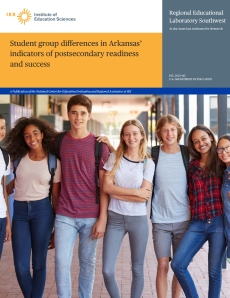

Regional Educational Laboratory Southwest partnered with the Arkansas Department of Education to examine Arkansas’s middle school and high school indicators of postsecondary readiness and success, building on an earlier study of these indicators (Hester et al., 2021). Academic indicators include attaining proficiency on state academic examinations, grade point average, enrollment in advanced courses, and community service learning. Behavioral indicators include attendance, suspension, and expulsion. Using data on statewide grade 6 cohorts from 2008/09 and 2009/10, the study examined the percentages of students who attained the readiness and success indicators and the percentages of students who attained postsecondary readiness and success outcomes by gender, race/ethnicity, eligibility for the National School Lunch Program, English learner student status, disability status, age, and district locale. The study also examined whether the predictive accuracy, specificity, and strength of the indicators varied by these student groups.
Four key findings emerged. First, the attainment of indicators of postsecondary readiness and success differed substantially for nearly all student groups, with the number of substantial differences on academic indicators exceeding the number of substantial differences on behavioral indicators. The largest number of substantial differences in the attainment of academic indicators were between Black and White students, between students eligible and ineligible for the National School Lunch Program (an indicator of economic disadvantage), and between students who entered grade 6 before and after age 13. Second, attainment of postsecondary readiness and success outcomes varied substantially across student groups, with the largest differences in postsecondary readiness and success outcomes between students with and without a designated disability. Third, predictive accuracy (the percentage of students with the same predicted and actual outcomes) was similar across student groups. Finally, English language arts and science proficiency were the only middle school indicators that varied substantially across student groups in their predictive strength (the magnitude and significance of the association between an indicator and an outcome). In high school, science proficiency, enrollment in community service learning courses, and never being expelled were the only indicators whose predictive strength varied substantially across student groups.
Leaders at the Arkansas Department of Education and in Arkansas districts can use these findings to identify appropriate indicators for postsecondary readiness and success and to target supports toward student groups who most need them. These findings can help leaders understand and address disparities such as inequitable access to resources and supportive learning environments.
Online Availability



